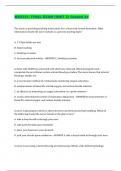Resume
Samenvatting - Macroeconomics
- Cours
- Macroeconomics
- Établissement
- Universiteit Antwerpen (UA)
Samenvatting - Macroeconomics UA Social Economic Sciences. Samenvatting met grafieken (getekend en van de cursus), notities erbij en tekst van de cursus zelf.
[Montrer plus]












